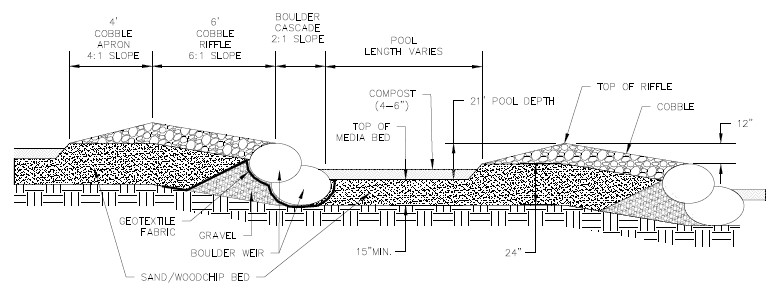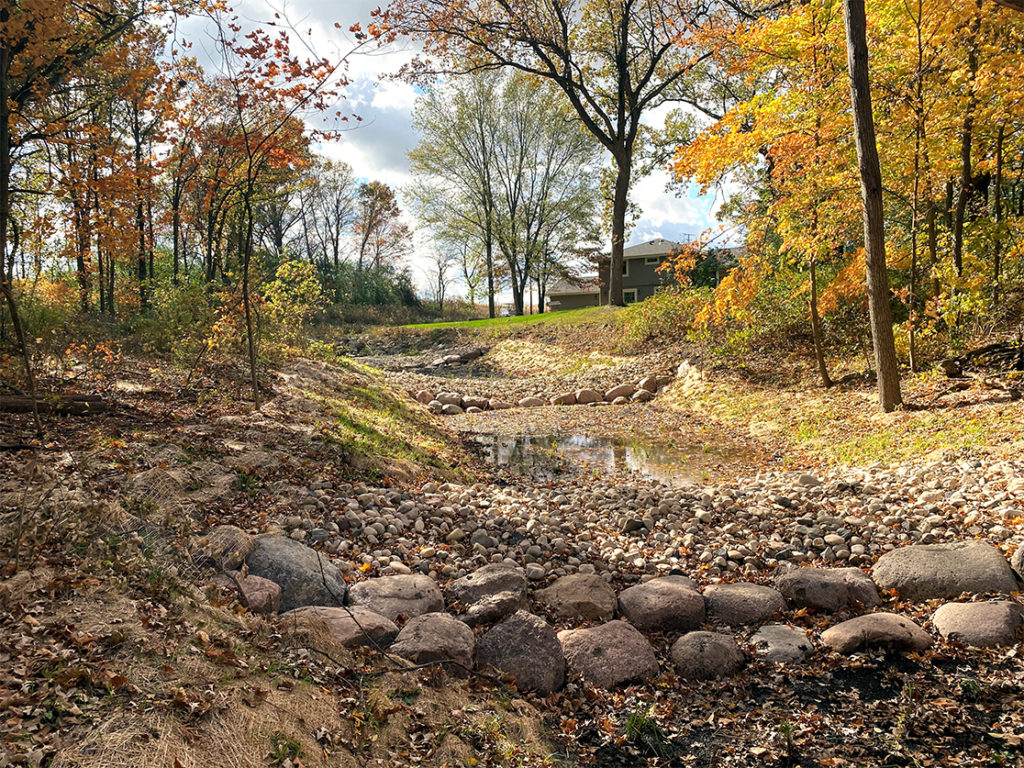While the design of swales, infiltration practices, ponds, or storm sewer can be common practice, regenerative stormwater conveyance systems can be used as a substitute in many situations and provide a number of benefits. Regenerative stormwater conveyances offer a unique solution to addressing water quality and quantity concerns.
Regenerative stormwater conveyances are synonymous with regenerative step pool storm conveyance, regenerative stream channel and biofiltration conveyance, along with many other names. The similarity with all of these systems is that they work to convey and treat stormwater runoff using a series of riffles and pools of sand/woodchip media beds. Regenerative stormwater conveyances can be used to stabilize erosive channels or as a stormwater system for new developments or even as a retrofit to old and/or failing systems.

Regenerative stormwater conveyance systems offer an innovative solution to addressing water quality and quantity concerns.
How do regenerative stormwater conveyances work?
Regenerative stormwater conveyances consist of a series of riffles and pools. The diagram below shows a typical profile section of a regenerative stormwater conveyance. Stormwater enters the system into a pool and depending on the characteristics of a particular site, this could be a plunge pool filled with riprap or it could be the start of sand/woodchip media beds. Once the runoff enters this bed, it will either infiltrate (small storms) into the media bed or it will start to pond (larger storms).
As the pools start to pond in larger storms, the runoff will spill over a parabolic-shaped weir constructed of cobbles. These cobbles will vary in size but typically have a diameter of approximately six inches. Once the ponding water overtops the weir, it will move over and through the cobble riffle and cascade down a set of large boulders into a second pool. When the runoff reaches the second pool, the process repeats itself with multiple weirs and pools, depending on the length and gradient of the system, until it reaches its ultimate discharge point.

This diagram shows the standard components of a regenerative stormwater conveyance system.
The Benefits of Regenerative Stormwater Conveyances
Regenerative stormwater conveyances provide significant energy dissipation, which is why these systems are often used to replace degraded, highly erosive channels and ravines. The slowing of water as it moves through the system allows for vegetation growth and reduces the chances of future erosion. The rock weirs help to spread out the flow path of runoff, which can help pass larger rain events in a safer manner. The pools help to infiltrate stormwater and settle out any pollutants that enter the stormwater system. The pools also provide detention during rain events that will help reduce flooding downstream of the system. Not only do regenerative stormwater conveyances provide all of the benefits mentioned above, but they also provide a diverse habitat for the surrounding wildlife and can be aesthetically pleasing.
Contact Us
raSmith’s engineers have assisted clients on projects using regenerative stormwater conveyances for stormwater management solutions. For example, regenerative stormwater conveyance was instrumental in the stabilization of the Reck South Ravine in the Village of Somers, Kenosha County. The treatment included regrading to create infiltration pools upstream of nine rock riffles and revegetating the banks with native grasses and forbs.
Along with using regenerative stormwater conveyances, our experts are experienced with a variety of stormwater management solutions, and they’re eager to assist you on your next project. Learn more about our water resources services.

Regenerative stormwater conveyance was effectively used for the Reck South Ravine stabilization project in Kenosha County, WI.
